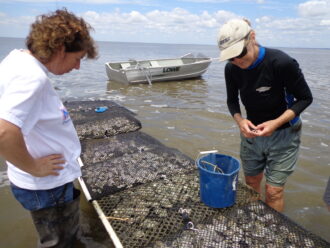Oyster production is a key contributor to the local food economy in New Jersey’s Delaware Bay. The “merroir” of the Bay’s tide flats gives oysters their unique and desired taste. However, recent increases in illnesses caused by raw oyster consumption threaten the Bay’s oyster farming future.
The culprit is Vibrio parahaemolyticus (Vp), a bacterium commonly found in coastal waters whose pathogenic strains have substantially increased over the past five years, according to the Centers for Disease Control.
Although oyster farms follow strict post-harvest standards to stem Vp contamination, Lisa Calvo and other researchers at Rutgers University Haskin Shellfish Laboratory took next steps in supporting safe oyster production with a Northeast SARE Partnership Grant. The team examined Vp under a popular intertidal method, known as a rack and bag grow out system, that previous research suggested increased Vp levels due to air exposure.
Working with farmer Elizabeth Haskin, the team compared water temperatures and Vp presence between a) intertidal production that exposes oysters to air during low tide and b) subtidal methods that keep oysters below tidal flows.
Because warmer waters encourage Vp growth, the team monitored temperatures over the summer months. Although they observed greater temperature fluctuations under intertidal conditions, they found no significant differences in average temperatures—and therefore no increased Vp risks—between intertidal and subtidal production.
Genetic testing did reveal Vp in oysters but at levels far below FDA safety thresholds. Intertidal oysters did not show expected elevated Vp levels, suggesting that air exposure may not contribute to Vp increases.
Researchers say these preliminary findings provided critically needed information on the interaction of Vp and aquatic farming practices. They plan to conduct more research to confirm these results beyond one year and one farm to help Delaware Bay farmers continue to produce safe and high quality oysters.
